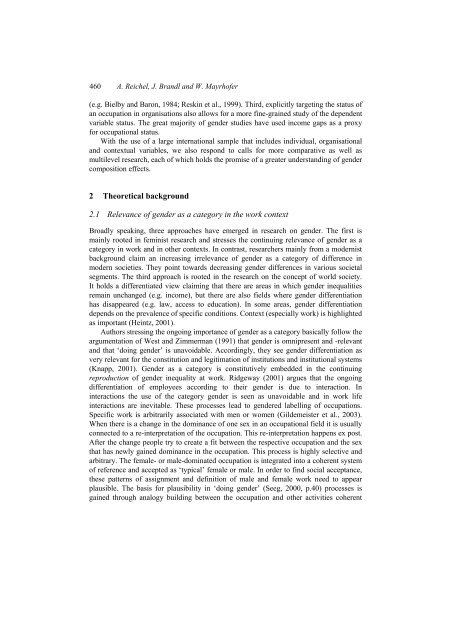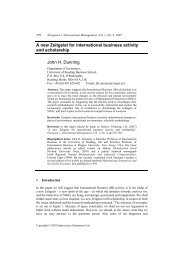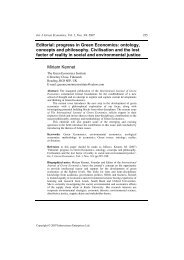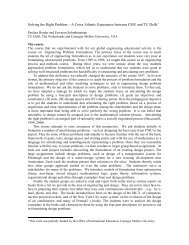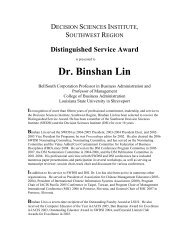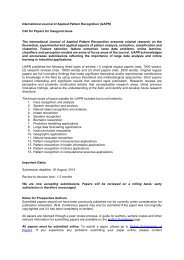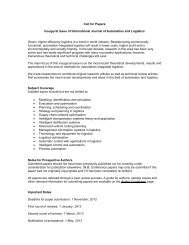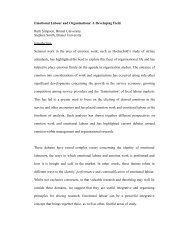View - InderScience
View - InderScience
View - InderScience
Create successful ePaper yourself
Turn your PDF publications into a flip-book with our unique Google optimized e-Paper software.
460 A. Reichel, J. Brandl and W. Mayrhofer<br />
(e.g. Bielby and Baron, 1984; Reskin et al., 1999). Third, explicitly targeting the status of<br />
an occupation in organisations also allows for a more fine-grained study of the dependent<br />
variable status. The great majority of gender studies have used income gaps as a proxy<br />
for occupational status.<br />
With the use of a large international sample that includes individual, organisational<br />
and contextual variables, we also respond to calls for more comparative as well as<br />
multilevel research, each of which holds the promise of a greater understanding of gender<br />
composition effects.<br />
2 Theoretical background<br />
2.1 Relevance of gender as a category in the work context<br />
Broadly speaking, three approaches have emerged in research on gender. The first is<br />
mainly rooted in feminist research and stresses the continuing relevance of gender as a<br />
category in work and in other contexts. In contrast, researchers mainly from a modernist<br />
background claim an increasing irrelevance of gender as a category of difference in<br />
modern societies. They point towards decreasing gender differences in various societal<br />
segments. The third approach is rooted in the research on the concept of world society.<br />
It holds a differentiated view claiming that there are areas in which gender inequalities<br />
remain unchanged (e.g. income), but there are also fields where gender differentiation<br />
has disappeared (e.g. law, access to education). In some areas, gender differentiation<br />
depends on the prevalence of specific conditions. Context (especially work) is highlighted<br />
as important (Heintz, 2001).<br />
Authors stressing the ongoing importance of gender as a category basically follow the<br />
argumentation of West and Zimmerman (1991) that gender is omnipresent and -relevant<br />
and that ‘doing gender’ is unavoidable. Accordingly, they see gender differentiation as<br />
very relevant for the constitution and legitimation of institutions and institutional systems<br />
(Knapp, 2001). Gender as a category is constitutively embedded in the continuing<br />
reproduction of gender inequality at work. Ridgeway (2001) argues that the ongoing<br />
differentiation of employees according to their gender is due to interaction. In<br />
interactions the use of the category gender is seen as unavoidable and in work life<br />
interactions are inevitable. These processes lead to gendered labelling of occupations.<br />
Specific work is arbitrarily associated with men or women (Gildemeister et al., 2003).<br />
When there is a change in the dominance of one sex in an occupational field it is usually<br />
connected to a re-interpretation of the occupation. This re-interpretation happens ex post.<br />
After the change people try to create a fit between the respective occupation and the sex<br />
that has newly gained dominance in the occupation. This process is highly selective and<br />
arbitrary. The female- or male-dominated occupation is integrated into a coherent system<br />
of reference and accepted as ‘typical’ female or male. In order to find social acceptance,<br />
these patterns of assignment and definition of male and female work need to appear<br />
plausible. The basis for plausibility in ‘doing gender’ (Seeg, 2000, p.40) processes is<br />
gained through analogy building between the occupation and other activities coherent


